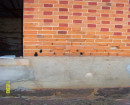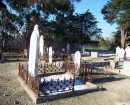Mortlake Avenue of Honour
Hamilton Highway, Mortlake VIC 3272
-
Add to tour
You must log in to do that.
-
Share
-
Shortlist place
You must log in to do that.
- Download report
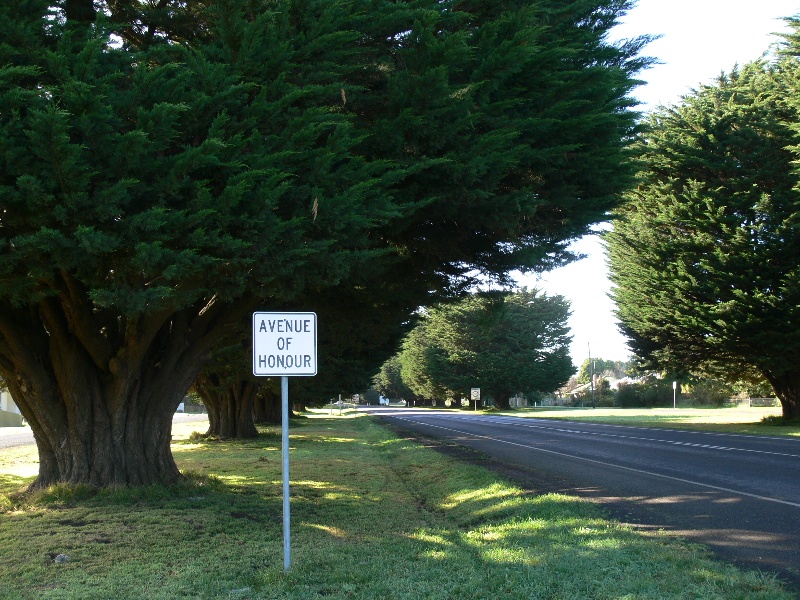

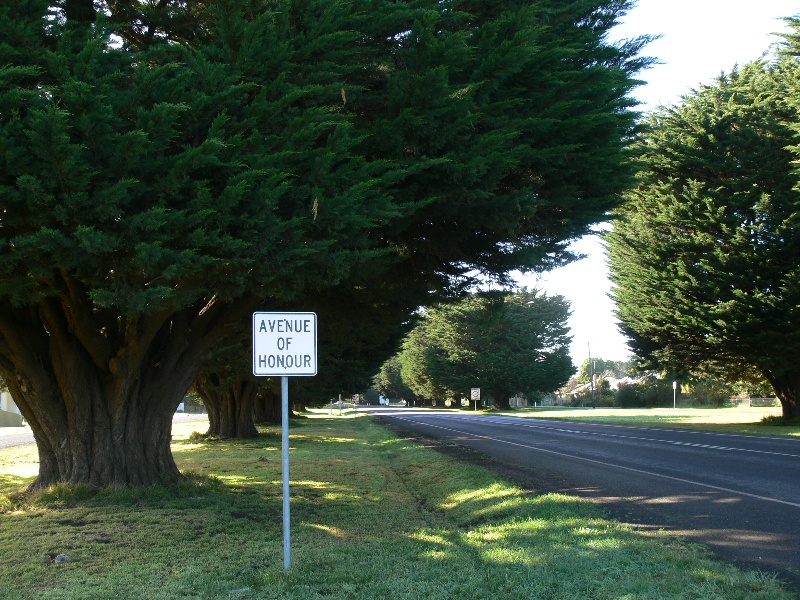
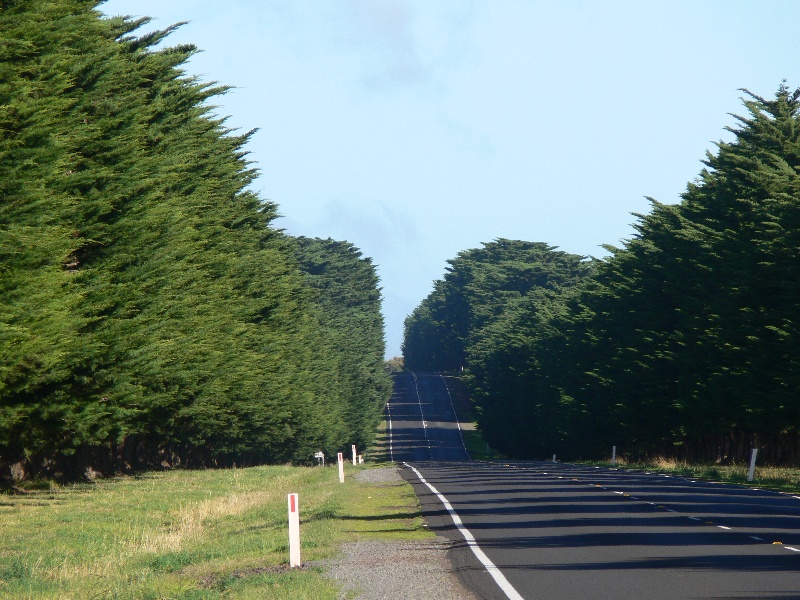
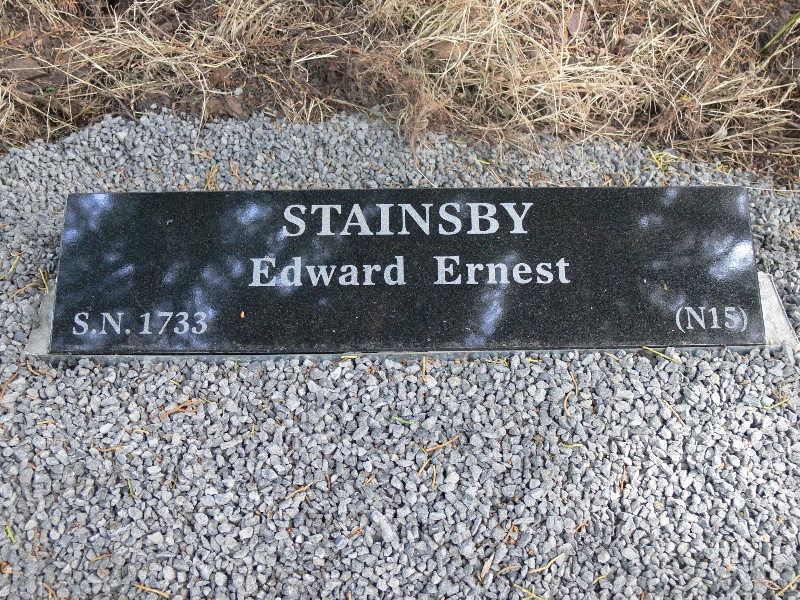
Statement of Significance
The Mortlake Avenue of Honour on the Hamilton Highway, Mortlake, comprises an avenue of 191 Monterey Cypress (Cupressus macrocarpa) that were planted as an entrance to the town of Mortlake from the eastern approach (or Darlington side). The trees were planted in the wake of World Wars I and II in memory of the soldiers who fought.
How is it significant?
The Mortlake Avenue of Honour on the Hamilton Highway, Mortlake, is of historical, scientific (horticultural), aesthetic, and social significance to the State of Victoria.
Why is it significant?
The Mortlake Avenue of Honour, first planted in 1919, is of historical significance to the State of Victoria as an impressive, intact and integral part of the Victorian network of avenues of honour; at one time this totalled some 128 avenues throughout Victoria, but is now much reduced. It is representative of plantings that first appeared in Australia during World War I, which commemorated all those who enlisted for service in an egalitarian form where each individual was equally recognised for their service regardless of rank. [from 'Eurack Avenue of Honour' citation, Heritage Victoria]
The Mortlake Avenue of Honour on the Hamilton Highway, Mortlake, is of local historical and social significance for its commemoration of the local men who served overseas in World Wars I and II. The intact brass name plates set beneath many of the trees add to this significance.
The Mortlake Avenue of Honour is of scientific (horticultural) significance to the State of Victoria as a record of the growth of a particular species planted at a known time. It is believed to be the longest avenue of mature Monterey Cypress in Victoria.
The Mortlake Avenue of Honour is of aesthetic significance to the State of Victoria as an intact and imposing landscape element, with the uniform planting of Monterey Cypress (Cupressus macrocarpa) forming a stark contrast to its pastoral surroundings, and for providing an attractive and impressive entry to the town of Mortlake. It is second only in length to the Ballarat Avenue of Honour, and is the longest, most intact and most impressive avenue in south-west Victoria. This extensive avenue of Monterey Cypress makes an important contribution to the distinctive landscape character of Mortlake and Moyne Shire, and of the Western District generally.
/
The Mortlake Avenue of Honour if of local social significance for its relationship to the community as a memorial to those who served in world wars I and II, and for its continuing commemorative importance. It remains as an indication of the involvement of Victoria's small communities in commemorating the sacrifices of their volunteers, and the loss and sorrow experienced by small rural areas across Victoria. ['Eurack Avenue of Honour' citation, Heritage Victoria]
-
-
Mortlake Avenue of Honour - Physical Description 1
This avenue consists of 191 mature Monterey Cypress (Cupressus macrocarpa) planted along the Hamilton Highway. The trees appear to be of differing ages, with trees making up the eastern side of the avenue appearing to be somewhat younger than those on the western side, possibly indicating the former were planted in the 1940s. No name plaques were seen in the vicinity of the eastern trees, however name plaques were observed at the base of a number of trees in the road cutting. Names include G. Donnelly, G. Clifford, G. Melville, Dr Lee, D. McKinnoch. Name plates are made of brass (metal) fixed on timber posts. Replacement trees have been planted in gaps in the avenue, ensuring that the avenue remains intact. Most of the trees appear (visual inspection only) to be in good condition, with the exception of a couple in the road cutting. The trees have been clipped to form a barrel shape.
The National Trust Significant Tree Register noted some years ago: Avenue planted in two sections following WWI and WW2. They are clipped into a barrel shape. Spacing 19-20.4m. Measurements for WWI trees. WW2 trees: 2.0m circumference, 7-10m spread and 12-13.5m height. [NTA] 196 trees for WW1&2 [NT Sig Tree Register]
COMPARATIVE ANALYSIS
Avenues of honour are an ancient tradition, but planted on a large scale appear to be a uniquely Australian phenomenon. Research suggests that there are no known avenues of honour in the United States or in Britain, and a very limited number (3) were planted in New Zealand (and were likely to have been influenced by the Australian example) [Richards, p. 121]. Of the Australian states, Victoria had by far the greatest number of such avenues. Figures vary, but by 1921 between 92 and 128 avenues of honour had been planted in Victoria, as well as 14 in New South Wales, 12 in Tasmania, 2 in Western Australia, and one in South Australia. The greatest concentration of Avenues of Honour in Victoria occurred in the Central Highlands region of Victoria, stimulated, it is surmised, by the planting of the first major example - the Ballarat Avenue of Honour' between 1917-1919 [Ballarat Avenue of Honour at http://www.ballarat.com/avenue.htm].
After the Ballarat Avenue of Honour, which consisted (in 2004) of 3192 cypresses and covers 22 kilometres of the Western Highway [Lismore booklet], the avenue at Mortlake is one of the longest, most intact and most impressive avenue of honour in the State. Few such avenues retain their name plates, which Mortlake does. The Mortlake Avenue of Honour is the outstanding example of the typical cypress avenue of honour planted in western Victoria, all of which are much smaller and mostly do not retain their name plates.
Other avenues of honour in Moyne Shire that feature Monterey Cypress exist at Caramut, Orford, Hexham, and Ellerslie (the Cypress avenue of honour at nearby Woolsthorpe was removed in October 2005). These additional avenues are part of an important collection of avenues of honour in the Shire which taken together may also be considered to be of State significance.Mortlake Avenue of Honour - Physical Conditions
Good
Mortlake Avenue of Honour - Integrity
Intact
Veterans Description for Public
Mortlake Avenue of Honour - Veterans Description for Public
The Mortlake Avenue of Honour, on the Hamilton Highway, comprises of 191 Monterey Cypress (Cupressus macrocarpa) that were planted as an entrance to the town of Mortlake from the eastern approach (or Darlington side) in 1926. The trees were planted to commemorate the service of district men in the First World War. Of the 134 men from Mortlake and surrounding area who left home to serve in the First World War, a total of 42 men never returned. The name plaques along this avenue were refurbished in 2011.
There was some controversy early on, as trees were also planted as soldiers memorials in the recreation reserve, and the recipients of these trees 'felt that they were being relegated to the back blocks.' The local paper reported in July 1919: 'The planting of the trees was carried out last Tuesday and altogether 85 trees were planted. To complete the avenue another fifty trees at least are required so that every man who enlisted from the town may be represented.' It is not clear whether trees were planted for every man who enlisted. Today the avenue is the more remarkable for the intact brass name plates still set beneath many of the trees. The names on the plates include G. Donnelly, G. Clifford, G. Melville, Dr Lee, D. McKinnoch.
At the end of the Second World War, additional trees were planted. It is believed that around 202 trees made up the full avenue, and with 11 or 12 trees missing, there are 191 trees still standing (100 on the north side and 91 on the south).The large numbers of trees planted in the Mortlake Avenue of Honour, and their maintenance over the years, owes to the strength of the RSL in the district following the First World War and the subsequent development of soldier settlement estates, which drew over two hundred returned soldiers to the Shire.
In Australia, commemorative trees have been planted in public spaces since the late nineteenth century. Arbor Days were held regularly in most Victorian State Schools during the late 1800s and early 1900s, and numerous trees were planted in parks in Melbourne and throughout Victoria to mark the visits of important and famous people.
This tradition of commemorative planting was continued in 1901 when at the end of the Boer War trees were often planted for each soldier of the district who was killed in South Africa. These plantings, however, rarely consisted of more than two or three trees in each town.
During and after the First World War avenues of honour consisting of trees lining significant streets became a popular form of commemoration. They represented a new egalitarian approach to the commemoration of soldiers where rank was not a consideration: each tree symbolises a person.
Avenues of honour are a uniquely Australian phenomenon. Australians, and in particular Victorians, embraced the idea of planting them more enthusiastically than any other country in the world. Dating from May 1916, the Eurack Avenue of Honour is the earliest known avenue of honour to be planted in Victoria.
By the time of the Second World War avenues of honour had declined in popularity as a means of commemoration. Today it is estimated that over 300 avenues of honour have been planted in Victoria to commemorate service personnel since 1901.Heritage Study and Grading
Moyne - Moyne Shire Heritage Study Stage 2
Author: Helen Doyle in association with Context P/L
Year: 2006
Grading: State
-
-
-
-
-
Mortlake Avenue of Honour
 Vic. War Heritage Inventory
Vic. War Heritage Inventory
-
1 Brockenshire Street
 Yarra City
Yarra City -
1 Bundara Street
 Yarra City
Yarra City -
1 Forster Street
 Hobsons Bay City
Hobsons Bay City
-
-




